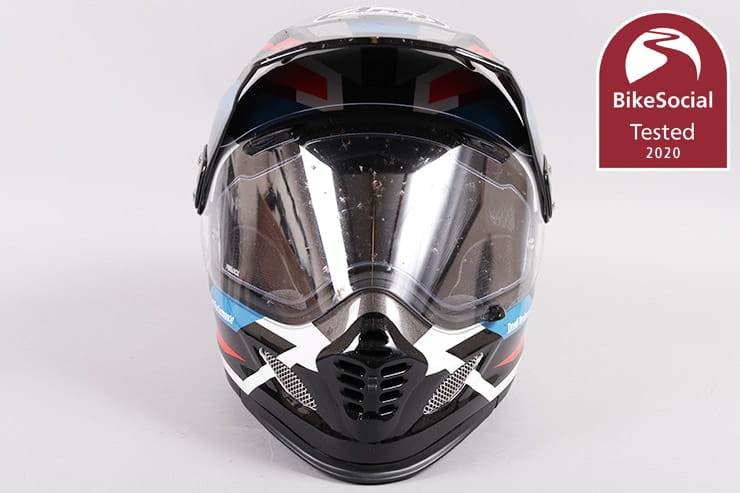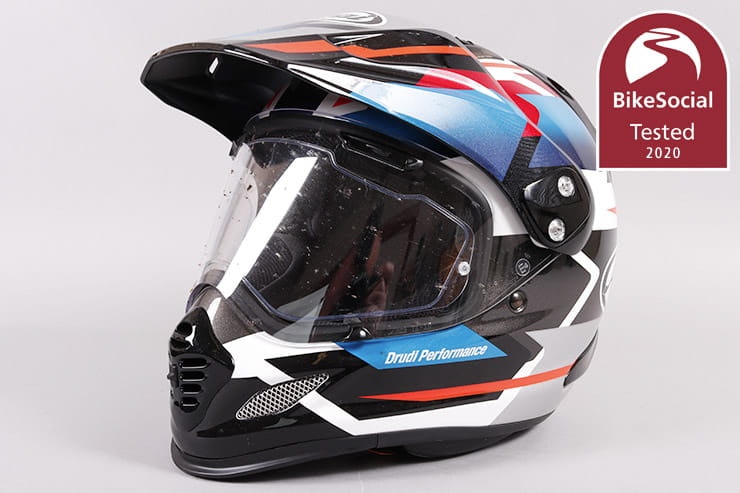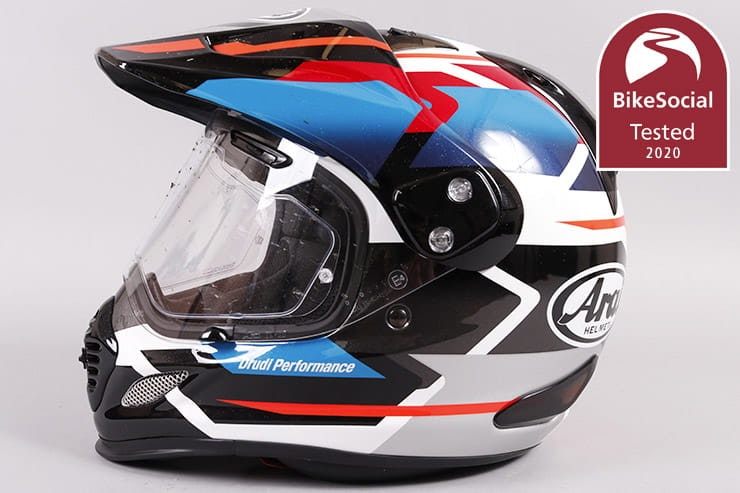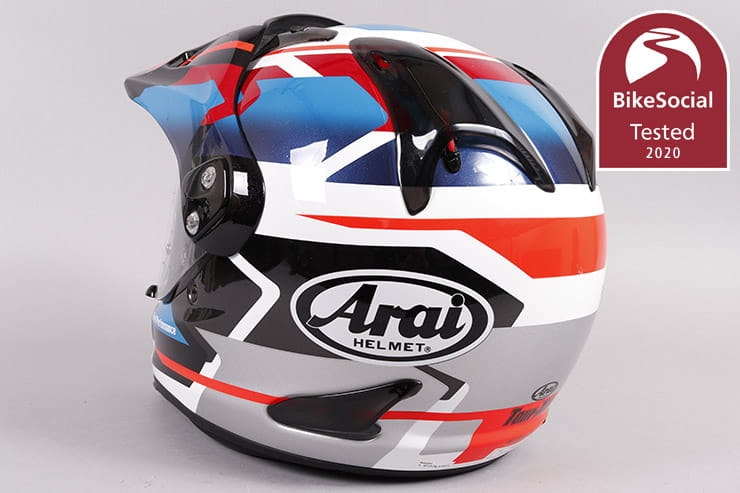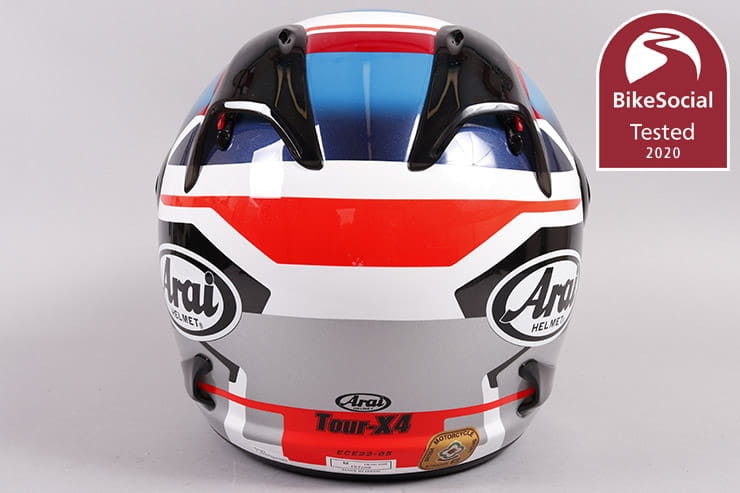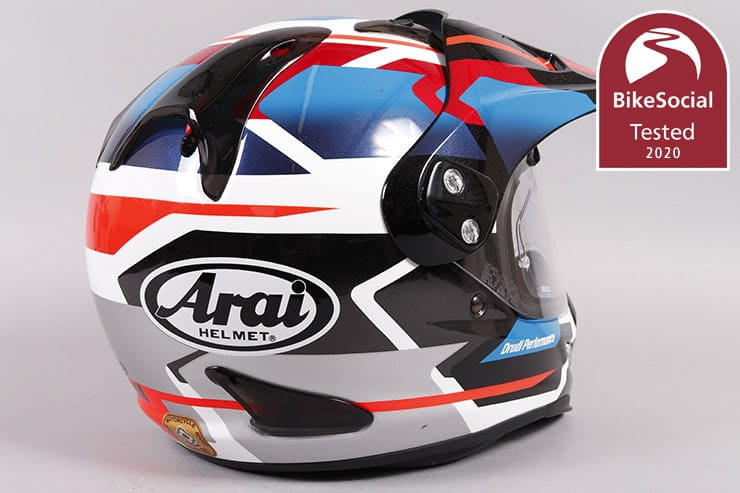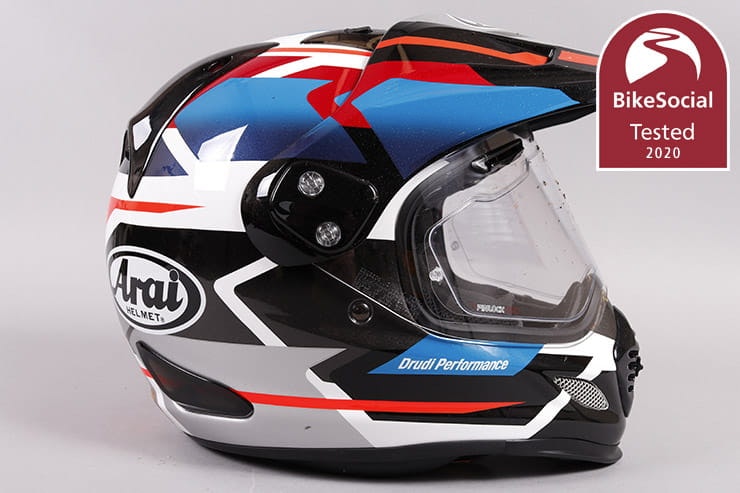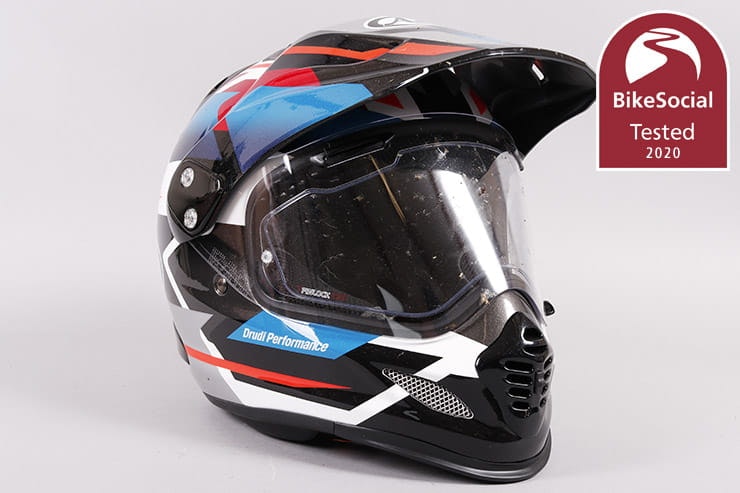Tested: Arai Tour-X 4 adventure helmet review
By John Milbank
Consumer Editor of Bennetts BikeSocial
18.06.2020
Date reviewed: June 2020 | Tested by: John Milbank | Price: From £499.99 | www.whyarai.co.uk
The Arai Tour-X 4 on review here is a premium helmet designed – says Arai – for adventure riding, grand touring and off-road riding. The removable peak and visor mean you can also use it as a standard full-face, or with goggles.
I’ve been using it on a BMW S1000XR, Kawasaki Versys 1000 and a Royal Enfield Interceptor 650…
Excellent ventilation
Peak invaluable during evening rides
Can be worn in several different styles
Peak adds noise, particularly with some screens
Peak also adds drag when turning head, making neck tired over time
Visor is annoyingly fiddly to remove
The Tour-X 4 can be used in four different set-ups. Apologies for the out-of-style photos but my studio is out of action while I build a new shed!
Outer shell
On test here is the ‘Depart’ colour scheme of the Arai Tour-X 4 – this red, white and blue finish is one of six designs that add £80 to the price of the plain matt or gloss black versions that are also available.
The graphics are very well applied, with a deep gloss carrying a fine metal-flake covering the helmet, including the Arai labels.
The shell is Arai’s Complex Fibre Laminate – a mixture of fibres and resin that create an extremely strong outer. Inside is a single-piece, multi-density expanded polystyrene liner that’s soft at the top and front, while blending into a firmer structure at the sides and rear.
Like all Arais, the Tour-X 4 is handmade and inspected five times before leaving the factory in Japan.
While clearly an adventure-style helmet, the Tour-X 4 maintains Arai’s trademark smooth shell silhouette, with vents and peak designed to snap off in an impact to reduce the torsional impact on the brain in a crash. It’s a similar principal to MIPS, which you can read about here.
Weight
With visor and peak fitted, the Tour-X4 weighs 1,710g. That’s 109g more than the similar-style Shoei Hornet ADV, and a good 200g more than a typical standard full-face lid.
Arais have a reputation for being heavy, but that’s mainly down to the thick, solid outer shell construction, and only noticeable when picking them up and comparing them directly to other brands.
I’ve yet to wear any motorcycle helmet from any brand that I’ve considered to be too heavy on my neck (and I’m no power-lifter), and this is no different. But…
Having a peak does create increased drag – this one is well designed and doesn’t try to flick your head back like some can while riding, though like all others, you can feel the wind when you look to the side or perform a life-saver; while not to the extent that you’ll struggle to move your head, over a longer ride at speed this can be quite tiring.
This drag isn’t unique to the Arai of course – I’ve been comparing it directly to the Shoei Hornet ADV, which reacts just the same, as did the Schuberth E1, though that also suffered from a horrible shaking peak that was pretty distracting in use.
Why do some helmets have peaks?
Off-road helmets typically have peaks, in part to shield you from mud and stones thrown up by the bike in front on a motocross track, but also – and this is where they’re particularly valuable on the road – to shield your eyes from the sun.
As many riders know, low sun – particularly when commuting in the autumn – can be dangerously dazzling in the evening, but by just tipping your head down slightly it’s possible to quickly and safely shield your eyes from the glare.
Ventilation
The Arai Tour-X 4’s ventilation is outstanding.
Generally, the venting on Arais tends to be good, but I’ve never seen a helmet with as many vents as this..
Open/closed central chin vent directs air up across the visor and to the brow.
A vertical slider can be opened inside the chin to direct air straight from the chin vent to the mouth.
Two mesh vents on the chin also feed two horizontal sliders that can be opened to give more air around the mouth and chin.
Two vents in the visor can be opened or closed to blow onto the brow.
Two scoop vents on the top of the head can be opened or closed, feeding air through two approximately 8mm holes.
Two large exhaust ports are each fed by two 8mm holes each via two-stage and closed levers.
Two always open exhaust vents take air from the lower rear sides of the head via another two 8mm holes.
The back of the neck skirt has a vent panel built in to help circulate air through this exposed padding.
The main exhaust vent covers can be easily removed (though not by accident) for cleaning
The vents are all designed to break off in an accident, though don’t worry; they don’t fall off randomly (I’ve used Arais since 1996). The two large exhaust spoilers are removable, using a clever latch in the levers to allow for easier cleaning.
The total of three vents that are operated inside the chin area are accessible thanks to the prominent front, though they’re a little fiddlier with thicker gloves on. Though to be fair, you’re not likely to be changing them much during a ride in winter.
With all the vents closed, the helmet seals up well, with only a little air movement around the bottom of the chin, which is reduced further by pulling down the adjustable chin skirt.
Open the vents and each provides a noticeable difference – the top vents don’t blow hard onto localised points at the top of your head, instead allowing air to move across the top and be expelled out of the total of six exhaust ports.
My only slight criticism of the vents is that the top ones can be a little easy to knock open or closed while operating, though as they’re the same design as those used on most other Arais, you soon get used to them.
Visor
The field of view from the visor – which is a unique shape to this model – is vast, giving excellent visibility to the sides and down. It’s obviously not a lid designed for sports bike use, so you won’t be laying across the tank with your head tucked behind the screen, but the vision while tipping the head down is still perfect either to the point that you have the peak blocking the sun, or that you can easily see out with the peak removed.
The visor seals well, with no water making it past the top aperture seal in our testing.
A Pinlock 120 is supplied, which gives the top level of anti-fog protection; the only way this will mist up is if a heavy-breathing rider keeps all the vents shut in deep winter (in any lid with a Pinlock, I have at least one vent open or my glasses steam up).
Adaptor plates are supplied to use the helmet without a peak, though it’s fiddly to get the plastic screws out to replace them as held by thin little plastic retainers to stop them getting lost. It’s a real shame that Arai doesn’t supply a second set of screws, retained on the blanking plates with two more retainers, as these would make swapping much easier, and also give you spares if you stripped them. Don’t be tempted to look for metal replacements – the screws are plastic so they can shear in the event of an accident and replacements are readily available from good dealers. Watch out too for the small plastic lugs that locate the peak on either side – if the peak gets bent too far with the screws slack it’s possible to shear one off.
The screws are retained on the peak with this thin plastic strip
Unfortunately, the Tour-X 4 doesn’t use Arai’s trademark quick-release visor system – you’ll still need to remove those four screws to get it off, which is a bit of a frustrating fiddle.
The visor doesn’t open all the way thanks to the peak blocking it, though it doesn’t stop you getting your hand in to fit glasses or scratch your head.
With the visor removed and the peak refitted, goggles fit easily into the aperture and sit comfortably against your face. The lip of the peak also keeps the strap in place; the goggles can tuck up onto the brow of the lid when you stop, while the strap stays put. This is better than putting the goggles over the chin, where your breath can quickly fog them,
You can also wear the helmet with no peak and goggles, the blanking plates again keeping the strap well seated. This does give it the look of a retro-style lid, somewhat like the Shoei Ex-Zero reviewed here.
Lining
The cheek pads, chin strap covers and skull cap are removable and washable, so it’s a shame to find that the neck skirt is glued in place – if you do ride off-road in dusty conditions a lot, washing this part will be that little bit more awkward.
As always, it’s a plush, comfortable and extremely well-made lining that can be modified to fit by good Arai dealers if necessary.
The cheek pads have quick-release straps to allow them to be pulled out if needed while the helmet’s on your head, allowing it to then be removed without straining your neck. A worthy addition, though out of the box these tabs are tucked out of sight, so while the instructions warn you not to leave them exposed in case they get caught while riding, I’d suggest leaving them poking out a touch, just in case they ever needed using by an emergency responder.
Fastening
As with all other Arais, the strap is a double-D fastener for a guaranteed secure fit every time. Personally, I do like the speed and convenience of a micrometric ratchet on lids I wear every day, but there’s nothing to complain about here.
Fit
Never more so than with a helmet, you must try before you buy – the fit should be snug all the way around the lid but with no pressure points; these might feel minor in the store but after an hour can feel like a knife being dragged across your skull.
There is no such thing as an ‘Arai head’ or a ‘Shoei head’ anymore, but we are all different, and some brands are more accommodating than others. One of the bonuses of Arai using a hard outer shell with a softer liner is that the interior more readily conforms to your own unique skull shape (another reason to never buy a second-hand lid), and I find the Tour-X 4 fits perfectly on my medium-sized bonce.
Unusually though, after about an hour’s riding I did find a tiny bit of pressure on the right-hand bottom edge of my jaw; nothing seems different here to other Arais I’ve worn, and a little fiddle with the strap seems to ease it. It’s nothing major, but I wonder if the helmet sits slightly differently on my head, giving an unusual pressure point.
I wear glasses, and can report that they fit in the lid easily without pressing against the side of my head.
While there aren’t specific cut-outs for intercom speakers, you will find that most fit in the back of the cheek pad linings of pretty much all Arais.
Noise
No helmet is quiet enough to be used without earplugs, despite what some may claim. If you don’t want a constant ringing in your ears after several years of day-in, day-out riding (as I suffer with), then please wear them.
It’s the varied fairings and screen that create noise in helmets, and while the Arai Tour-X 4 isn’t excessively noisy, it does – as you’d expect – deliver more noise than a standard full-face.
On the naked Royal Enfield Interceptor 650 I noticed a slight whistle from the peak at certain head positions, most prominent at 25-35mph. On the BMW S1000XR and Kawasaki Versys 1000 though, the whistle was much less noticeable.
But… put the screen to the upper position on either of those sport touring bikes and there was an unbearable drumming sound. With the screen down there was no real issue on either machine (I’m 5’10”), though it’s important to note that I had the same drumming sound with the Shoei Hornet ADV; this noise is going to depend on your bike and where you sit behind the screen ,and it’s clear that some owners don’t notice anything, while others stick lolly-pop sticks or even wheel weights to the peak to reduce it.
For more information on why earplugs are vital with any helmet, and advice on which are the best, click here.
The Tour-X 4’s most obvious competitor is the Shoei Hornet ADV
Arai Tour-X 4 review: Verdict
Despite the fact that you can wear the Arai Tour-X4 with or without the peak (and with or without the visor), most purchasers will be getting it for the fact that it offers such great shielding from the sun. So, it is vital to understand that noise will increase and that your neck will get more tired; peaks aren’t a blanket solution for everyone.
But, it is incredibly useful, especially for evening rides where it makes biking much safer. But is it better than the Shoei Hornet ADV? That depends what you want out of a lid; the Shoei doesn’t have as powerful venting and you can’t use it without the peak or the visor. On the other hand, it’s a lighter lid and that visor can be removed and replaced a lot more quickly, even with the peak on if you know what you’re doing. Both experience the same drumming sound with some bike screens, so the choice will come down to whether you want the more road-focussed Shoei or the more off-road capable Arai.
The Tour-X 4 is an excellent helmet with superb venting, just make sure you understand the implications (and benefits) of riding with a peak.
